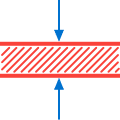Simply put, it is another way of cutting materials, including metals. The main difference between waterjet cutting and other cutting methods is that it is a non-thermal process. Non-thermal means it does not use heat. It is rather a mechanical process where material is removed by physical contact and material wear.
Cutting with water is possible because of the waterjet’s speed. It’s supersonic, meaning it comes out of the nozzle faster than sound travels. But water alone could not cut such a wide range of materials. Therefore, abrasives are added to the mix. The abrasive material is usually crushed garnet. You may recall it as the stone that makes sandpaper rough.
Using high pressure, the abrasives hit the material at a great speed. This erodes the metal bit by bit. The pressure for waterjet cutting is usually around 380 MPa but newer systems use pressures up to 620 MPa.
As the material removal is gradual, the temperatures cannot rise high. And any possibility of this happening is eliminated by the use of water. The waterjet is straight throughout its path, providing a straight cut along the material thickness.
Read more about the waterjet cutting process from our engineering blog.





